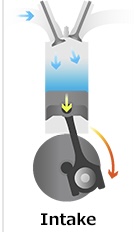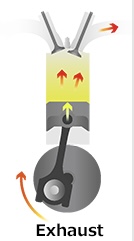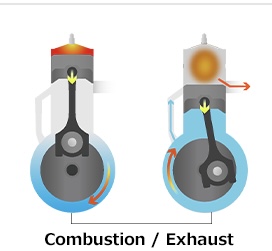| The intake stroke of an engine is the first out of four. The goal of the intake stroke is to draw in a mixture of air and fuel. At this point, the intake valve is opened and the piston moves down to create a vacuum. This vacuum helps guide the mixture into the cylinder. After the piston reaches the bottom of the cylinder, and is full of air and fuel, the intake valve closes. |
The compression stroke of an engine is the second. At this point, all valves of the engine are closed. This stroke compresses the air/fuel mixture making it easier to ignite. |
The power stroke of the engine is the third. After the piston reaches the top of the cylinder, with all the compressed air and fuel, the sparkplug creates a spark to ignite the air and fuel. This explosion pushes the piston down and creates the power that keeps the engine turning. It does this by spinning the flywheel, which is capable of storing inertia so it can push the piston through all the other strokes. |
And last but not least, the engine goes through the exhaust stroke. At this point, the exhaust valve is opened. The exhaust stroke is where the piston is pushed back up after the power stroke. This is to get rid of the exhaust as a result of the power stroke. Every engine goes through these 4 strokes thousands of times per min to propel a car or a motorcycle. |









